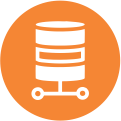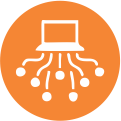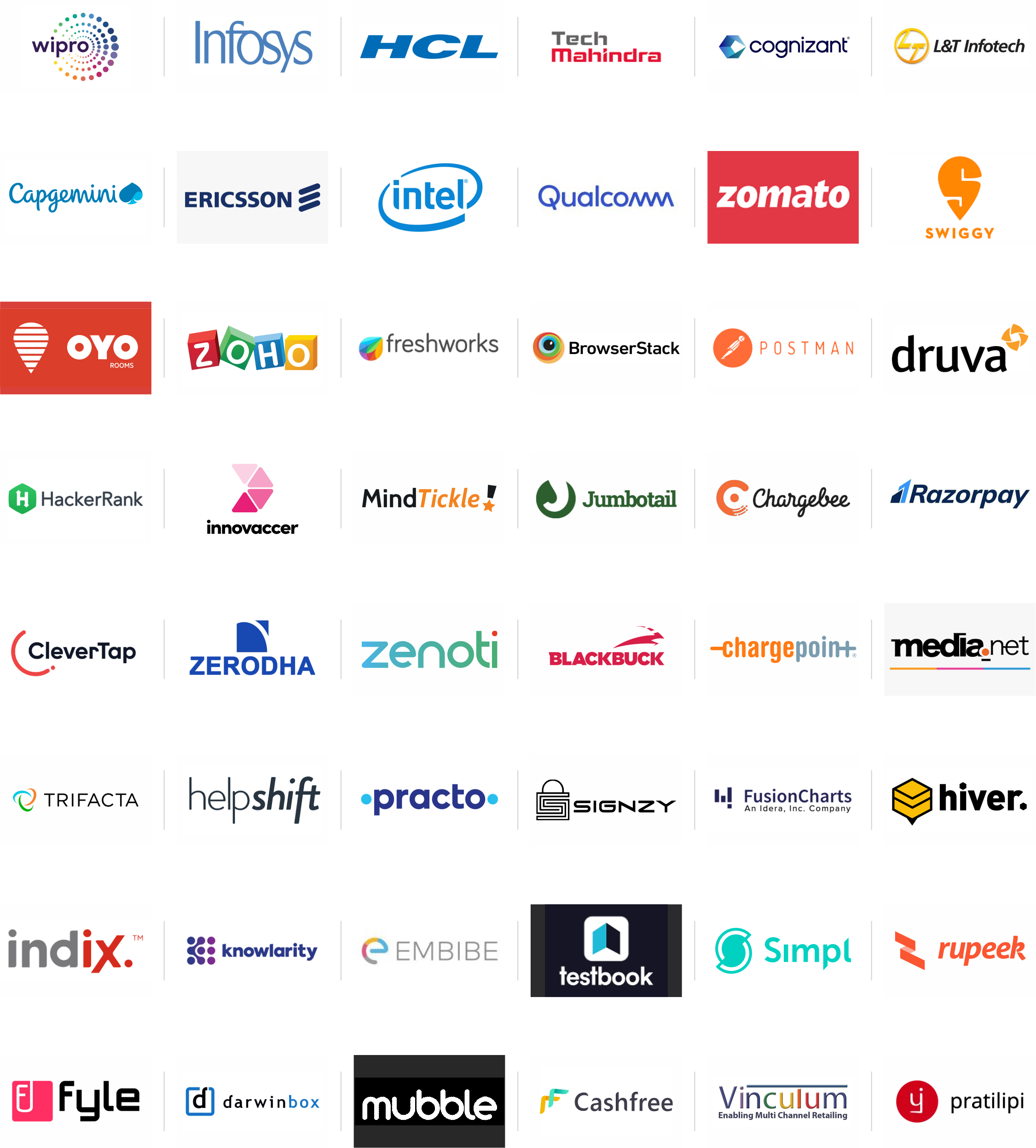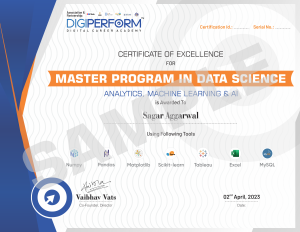Post Graduation Program in
Analytics, Machine Learning and AI
16 Data Science Modules Live Projects and Doubt Sessions Assignment & Case Studies
India’s Only Data Science Training Program was created to help you to build a successful career in data science from scratch. You will solve 75+ projects and assignments across the project duration working on Stats, Advanced Excel, SQL, Python Libraries, Tableau, Advanced Machine Learning & Deep Learning algorithms to solve day- day industry data problems in healthcare, manufacturing, sales, media, marketing, education sectors making you job ready for 30+ roles.

Course Fee
INR 90,000
( + 18% GST )

EMI Options
Upto 18 EMI’s

Duration
10 Months

Salary
Rs 5 to 25 LPA

Assignments
75

Batches
Offline – Online
Who Can Attend?
IT Professionals to Business Professionals, Statisticians and Mathematicians, Graduates and Post-Graduates and Professionals looking to switch careers. With millions of worldwide job openings, data scientist has become the hottest job of the decade.
Module 1: Introduction to Data Science
- Introduction to Data Science
- Definition and various terminologies used in Data Science
- Importance of Data Science and how various companies are leveraging it
- Various career paths in Data Science
- Understanding the tasks data professionals perform on day to day basis
- Types of Data Analysis
- Business Problem Understanding
- Tools used for Data Science
Module 2: Excel for Data Analysis
- Performing basic tasks including navigation and data entry
- Importing and cleaning data in Excel
- Essential formulae in Excel
- Analyzing data using LOOKUP Functions, filter, sort and
- Pivot Tables
- Data Visualization using Excel
Module 3: Statistics for Data Science
- Introduction to Statistics & its Application
- Inferential vs Descriptive Statistics
- Measure of Spread (Mean, Mode, Median)
- Variance and Standard Deviation
- Covariance & Correlation
- Introduction to Probability
- Normal Distribution
- Confidence Intervals and Z-Score
Module 4: Tableau
- Introduction to Tableau
- Data Connectivity in Tableau
- Creating Bar Charts, Area Charts & Maps
- Creating Treemaps, Heatmaps and Gantt Chart
- Understanding Joins & Data Blending in Tableau
- Creating Table Calculations
- Working with Parameters and Calculated Fields
- Creating Dual-Axis Charts
- Creating Groups and Sets
- LOD Expressions in Tableau
- Constructing Powerful Storylines for Presentation
- Advanced Dashboards in Tableau
Module 5: PowerBI
- Introduction to PowerBI
- Data Connectivity
- Power Query Editor
- Basic Table Transformations
- Grouping & Aggregating
- Pivoting & Unpivoting
- Creating a Data Model
- Introduction to DAX
- Visualizing Data with Reports
- PowerBI Optimization Tools
Module 6: Database Design & RDBMS
- Introduction to Database
- Understanding Table, Schema and Keys
- E-R Diagram and Normalization
- Introduction to SQL
- Selecting and retrieving data using SQL
- Performing DDL Commands in SQL
- Joins and Sub-queries in SQL
- SQL Case Study
- Window Functions in SQL
- Stored Procedure, Functions & Triggers
- Database Optimization
- Practicing Advanced Queries & Problem
- Solving with SQL
Module 1: Introduction & Setting up Environment
- Introduction to programming languages
- Difference between a compiled & interpreted language
- Uses of Python in different domains
- Case Study of companies using Python
- Installing Anaconda & setting up environment
- Writing first program
Module 2: Data Types and Operators
- Basic data types in Python
- Different Arithmetic, Logical & Relational Operators
- Comments and identation in Python
- Exploring Python Syntax
- Input Output Functions in Python
Module 3: Conditional Execution & Interations
- If Statement
- Chained Conditionals- if and elif
- Using range function
- While Loop Statement
- For Loop
- Break, Continue and pass statement
Module 4: Strings
- Working with Strings
- Indexing and Slicing in Strings
- The in and not in operator in Strings
- Useful String Methods
- Join and Split in Strings
Module 5: Lists & Tuples
- Working with List Data Type
- Getting values and dealing with negative indexes
- List slicing and concatenation
- Removing values using del statement
- The Tuple Data Type
- Converting types
Module 6: Dictionaries & Structuring Data
- Dictionaries vs Lists
- Key, Values and items methods
- The get and set default method
- Nested Dictionaries
- Using Data Structures to build real world things
Module 7: Functions
- def Statement with Parameters
- Return values and return statements
- Keyward Arguments
- Local and Global Scope
- Exception Handling
- Map,reduce, lambda and recursive functions
Module 8: Classes & Objects
- Understanding an Object
- Defining a class in Python
- Using the self keyword
- Attributes and methods in a class
- Constructor in Python
Module 9: Object Oriented Programming Concepts
- Inheritance
- Encapsulation
- Polymorphism
- Using the above concepts in a Live Project
Module 10: Regular Expression
- Finding Pattern of text
- findall method
- Metacharacters in regex
- Case-insensitive matching
- Managing complex regexes
Module 11: Accessing APIs
- Rest APIs and Python
- Getting information using API
- Using Facebook API
- Creating your own API
- ASSIGNMENT & PROJECTS:
- Web Scaping a e-commerce website
- Email Marketing Software
- Generative Al Project
Module 12: Dictionaries & Structuring Data
- Introduction to Web Scraping
- Methods in BeautifulSoup and Scrapy
- BeautifulSoup and Scrapy
- Scraping simple text with Selenium
- Basic browser automation
- Scraping Stock Data using Beautiful Soup
Module 1: Numpy
- Introduction to NumPy
- Creating Numpy Arrays
- Data Types in Numpy
- Indexing & Slicing in Numpy Arrays
- Mathematical Operations in Numpy-1
- Mathematical Operations in Numpy-2
- Joining & Broadcasting
- Mathematical & Universal Functions
- Numpy Security
- Practice Exercises
Module 2: Pandas
- Introduction to Pandas
- Data connectivity in Pandas
- Understanding Dataframe
- Basic Operations on Dataframe
- Indexing and Slicing
- Groupby and Aggregate Functions
- Merging & Joining Dataframes
- Using Pandas for timeseries data
- Pivot Tables in Pandas
- Practice Exercises
Module 3: Matplotlib
- Introduction to Matplotlib
- Examples of Data Visualization
- Facts and Dimensions
- Bar Graphs and Line Graphs in Matplotlib
- Scatter plot and Histograms
- Area Plot and Box plots
- Customizing your plots
- Creating Subplots
- Introduction to 3D Plots
- Summary & Practice Exercises
Module 4: Seaborn
- Introduction to Seaborn
- Line, Bar and Scatter Plots
- Distribution plot
- Styling Options
- Heatmaps in Seaborn
- Matrix Plots in Seaborn
- Violin Plot & Count plot
- Facet Grid
- MKDE Plot
- Practice Questions
- Add-On: Data Wrangling using Pandas Al
- Airbnb Data Analysis
- Visualizing Stock Market Data
- Visualizing Hospital Data
Module 1: Introduction to ML
- What is Machine Learning?
- Applications of Machine Learning
- MTerminologies in Machine Learning
- Supervised Learning vs Unsupervised Learning
- Deep Learning & Reinforcement Learning
Module 2: Exploratory Data Analysis
- Introduction to EDA
- Imputing or Removing Missing Values
- Handling Outliers
- Standardizing Values
- Numerical and Categorical Analysis
- Univariate and Mutivariate Analysis
Module 3: Linear Regression
- Introduction to Linear Regression
- Mathematical formulation of Linear Regression
- Building model and measuring its accuracy
- Using Gradient Descent for model optimization
- Linear Regression Implementation
- Multiple Linear Regression and its implementation
Module 4: Logistic Regression
- Introduction to Logistic Regression
- Sigmoid Function & Mathematical formulation
- Binary & Multivariate Logistic Regression
- Model Evaluation metrics
- Logistic Regression
- Implementation & Making Predictions using
Module 5: K-Nearest Neighbour
- Introduction to K-Nearest Neighbour
- Distance Metrics
- Bias and variance trade-off
- Mathematical formulation of KNN
- K-Nearest Neighbour Implementation
Module 1: Decision Trees
- Decision Tree basics
- Entropy and Information Gain
- Mathematical Formulation of Decision Tree
- Parameter tuning in Decision Trees
- Implementation of Decision Trees using Python
Module 2: Random Forest
- Pruning Introduction
- Bagging Introduction
- Random Forest Classifier Introduction
- Mathematical Formulation of Random Forest Classifier
- Model building using Random Forest
Module 3: Support Vector Machines
- Introduction to Support Vector Machines
- Linearly & Non-Lineary Separable problems
- Kernal Functions
- Advantages and Disadvantages
- Model Building using SVM
Module 4: Naive Bayes Algorithm
- Naive Bayes Illustration
- Introduction to Text Clustering
- MText Clutering-Inverse Document Frequency
- Mathematical Formulation of Naive Bayes
- Naive Bayes implementation using Python
Module 5: Principal Component Analysis & Boosting
- Introduction to PCA
- Mathematical Formulation of PCA
- Boosting basics
- Boosting vs Bagging
Module 6: Clustering
- Introduction to Clustering
- Various Clustering Methods
- MK-Means Clustering
- M Executing K-Means Clustering in Python
Module 7: Time Series Forecasting
- Introduction to Time Series
- Smoothing Techniques
- Introduction to AR Models
- Building AR Models
- Time series forecasting using Python
Module 8: Machine Learning Operations
- Principals of Model Selection
- Foundational Model and Engineering
- Machine Learning Deployment
- Machine Learning Testing
- Project and Change Management
- Machine Learning Operations business case
Module 9: The Concept of Neural Networks
- Introduction to Neural Networks
- Types of Neural Networks
- M Layers in Neural Networks
- Activation Functions
Module 10: Neural Networks - Feed-forward, Convolutional, Recurrent
- Feed-forward Neural Networks
- Convolutional Neural Networks
- Recurrent Neural Networks
- Applications of Neural Networks
Module 11: Generative Al
- Introduction to Generative Al
- Industry Applications and future of Generative Al
- Introduction to Prompt Engineering and ChatGPT
- Building ChatGPT Code Interpreter
- Zero Shot and Few Shot Prompting
- Chain of Thought Prompting
- Fundamentals of LLMs
- Applications of LLMs in Data Science
- Understanding LangChain
- Creating a project using LangChain
- Deploying GenAl project on Cloud
Module 12: Introduction to NLP
- What is NLP?
- History and evolution of NLP
- M Applications of NLP
- Challenges in NLP
- Overview of NLP pipeline
- Corpus and Corpus Linguistics
Module 13: NLTK Toolkit
- Introduction to the NLTK toolkit
- Preprocessing text data with NLTK
- Basic NLP tasks using NLTK (e.g., Part-of-Speech
- Tagging, Named Entity Recognition)
- Stemming and Lemmatization
- WordNet in NLTK
- Chunking and Chinking
- Sentiment Analysis with NLTK
Module 15: Cloud
- Introduction to Azure
- Azure Services Overview
- Azure Databricks
- Azure Datafactory
- Deployment on Cloud
Module 14: Pyspark
- Introduction to Spark
- Understanding Spark Architecture
- How Spark Executes Program on Cluster
- Understanding Spark Transformations
- Introduction to SparkSQL
- Getting Started with PySpark
- Using PySpark on Databricks
- Data Processing using PySpark
- Building Machine Learning model with PySpark









1. Python:
2. Data Visualization Tools:
3. Database Management Systems:
4. Version Control Tools:
5. Text Editors/IDEs::
- Healthcare Customer Feedback Analysis
- Management Teams Dashboard Creation
- Retails Store Sales Report Analysis
- Software Firm Employee Data Analysis
- Industrial Data Sets Classification & Comparison
- Charts & Graphs: Frequency Distribution Table, Pie-charts, Pareto Diagram, Histogram, Scatter Plots, Heatmaps, Bar Graphs & Many More
- Patient Disease Probability Analysis Using Healthcare Data
- Car Model & Menu Item Data Combination & Configuration Probability Analysis
- Manufacturing & Product Launch Data Classification & Analysis
- Customer Complaint Resolution Analysis Using Normal Distribution Curves
- Product Rating & Employee Productivity Analysis Usign Z-Score
- New Product Need Analysis Using Hypothesis Testing
- Inventory Management & Customer Segmentation Systems Using Vlook up & Hlook Lookup
- Sales Trend & Staffing Plan Creation using Pivot Tables
- Pricing Strategy & Financial Model Creation Using What if Analysis
- Sales & Operations Dashboard Creation
- Healthcare & Construction Reporting Automation Using Macros
- Retail Sales Opportunity Analysis Using PIVOT Charts
- Accounting Firm Statement Analysis Using Sparklines & Waterfall Chart
- FMCG Marketing spend To Sales Revenue Impact Analysis Using Regression Analysis
- Transportation Pricing Model Using Regression Analysis
1. Customer Lifetime Value Calculation:
The project involves calculating the customer lifetime value using SQL to understand the revenue generated by a customer over their lifetime.
2. Customer Churn Prediction:
This project involves building a predictive model using SQL to identify customers who are likely to churn based on their behavior and transaction history.
3. Interactive Dashboard for E-Commerce Sales:
The project involves creating an interactive dashboard using Tableau & SQL to analyze retail sales data, identify trends, and make data-driven decisions.
4. Customer Segmentation Dashboard:
This project involves creating a customer segmentation dashboard using Tableau to identify customer groups based on demographics, behavior, and purchasing patterns.
5. Movie Recommendation System:
The project involves building a movie recommendation system using Python and its libraries such as Pandas, NumPy, and Scikit-Learn. The recommendation system will suggest movies based on user preferences and ratings.
6. Sentiment Analysis on Twitter Data:
This project involves analyzing Twitter data using Python and its libraries such as NLTK and TextBlob to perform sentiment analysis and understand the overall sentiment of a particular topic.
7. Visualizing COVID-19 Data:
The project involves visualizing COVID-19 data using Python and its libraries such as Matplotlib, Seaborn, and Plotly to understand the impact of the pandemic on different countries and regions.
8. Visualizing Stock Market Data:
This project involves visualizing stock market data using Python and its libraries such as Pandas, Matplotlib, and Bokeh to understand the trends and patterns in stock prices over time.
9. Airbnb Data Analysis:
The project involves performing exploratory data analysis on Airbnb data to understand the patterns in the pricing, availability, and quality of Airbnb listings in different cities.
10. Bike Sharing Data Analysis:
This project involves performing exploratory data analysis on bike sharing data to understand the usage patterns of bikes in different cities and identify factors that influence bike usage.
11. House Price Prediction:
The project involves building a regression model using Python and its libraries such as Scikit-Learn to predict the prices of houses based on their features such as location, size, and amenities.
12. Credit Risk Prediction:
This project involves building a classification model using Python and its libraries such as Scikit-Learn to predict the credit risk of loan applicants based on their credit history and other factors.
13. Time Series Forecasting for Sales Data:
The project involves building a time series forecasting model using advanced machine learning algorithms such as ARIMA and LSTM to predict future sales trends and identify factors that influence sales.
14. Sentiment Analysis on Product Reviews:
The project involves building a sentiment analysis model using NLP techniques such as Word Embeddings and Recurrent Neural Networks (RNN) to analyze product reviews and understand the sentiment of customers towards different products.
15. Segmentation using Deep Learning:
This project involves using advanced deep learning techniques such as Fully Convolutional Networks (FCN) and U-Net to perform image segmentation and identify objects in images.
16. Machine Translation using Transformers:
This project involves building a machine translation model using advanced deep learning techniques such as Transformers to translate text from one language to
another.






Contact us today
Digiperform – Data Science & Analytics Academy
C-30, Third Floor, C Block, Sector 2, Noida, Uttar Pradesh 201301
+91-966 -755-1500














